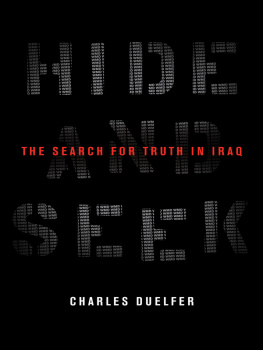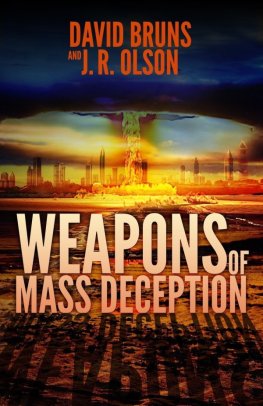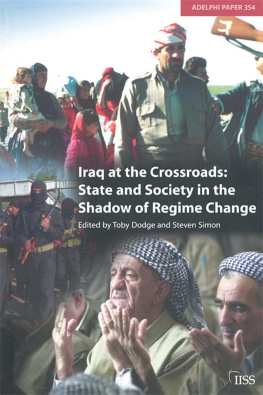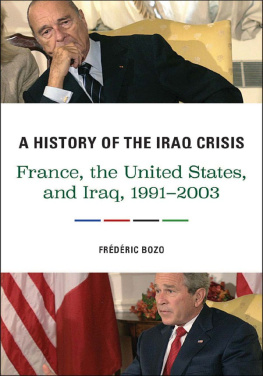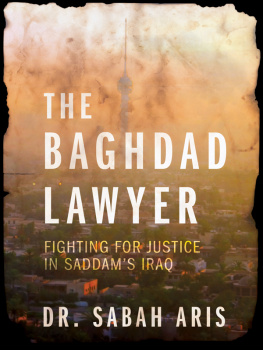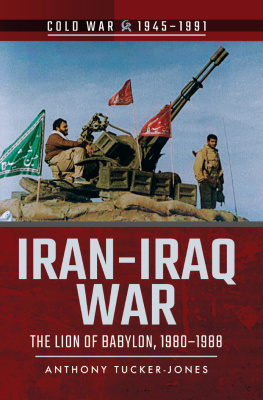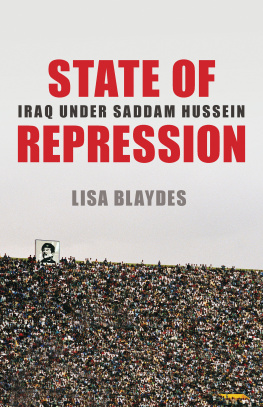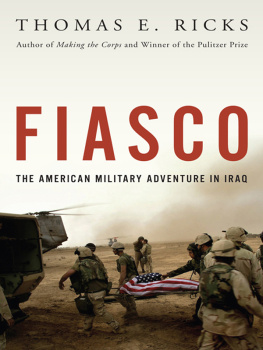Published in the United States by PublicAffairs, a member of the Perseus Books Group.
All rights reserved.
Printed in the United States of America.
No part of this book may be reproduced in any manner whatsoever without written permission except in the case of brief quotations embodied in critical articles and reviews. For information, address PublicAffairs, 250 West 57th Street, Suite 1321, New York, NY 10107.
PublicAffairs books are available at special discounts for bulk purchases in the U.S. by corporations, institutions, and other organizations. For more information, please contact the Special Markets Department at the Perseus Books Group, 2300 Chestnut Street, Suite 200, Philadelphia, PA 19103, call (800) 810-4145, ext. 5000, or e-mail .
A CIP catalog record for this book is available from the Library of Congress.
ISBN-13: 978-1-58648-557-3
eBook ISBN: 9780786744114
First Edition
PREFACE
Iraq didnt need to be this bad. Still, something had to be done. That muchis clear.
Six years after the invasion, sufficient time has now passed to make a reasoned, nonpolemical assessment of the course the United States followed in Iraq. Moreover, we are at a transitional point.
President George W. Bush decided to implement regime change in Iraq by force and spent much of his presidency trying to control the aftermath. President Barack Obama is now the first president since Richard Nixon who has not had to reckon with Saddam Hussein. President Obamas legacy, however, will be shaped by the uncertain outcome in Iraq. It may be a bright spot or a terrible stain. Post-Saddam Iraq remains an unstable country in an unstable regionand the stakes are still very high. As the United States withdraws, it will become clear whether the central government has coalesced with enough gravity to replace the force that Saddam used to maintain a unified Iraq. If not, divergent subnational interests, combined with Iranian meddling, may produce further disintegration or lead to another more authoritarian central government.
It can be said that primary responsibility for the future of Iraq is now up to the Iraqis. Those words have been said before, but the change in the U.S. administration gives them more meaning. The central Baghdad government must now broaden its support, reinforce its electoral mechanisms, and achieve an acceptable division of power and resources or it will collapse. The signs are not hopeful.Washington will not and cannot save it. Tehran cannot save it.
The immediate transition from the Saddam regime to something else is now over and a new phase has begun. This presents a moment to assess how we got here and perhaps to inform future decisions in Washington, Baghdad, Tehran, and elsewhere.
This book examines the events that led to the tragedy in Iraq from the perspective of someone who witnessed firsthand the array of issues both in Washington and in Baghdad. It is easy to forget now that there were very few Americans who knew anything firsthand about the Saddam regime immediately prior to the invasion.Today there are thousands of Americans who have been to Iraq. In the decade prior to the invasion, I was virtually the only senior American official who regularly dealt with the regime. As a result of my position as Deputy Chairman of the UN disarmament organization called UNSCOM, I became quite familiar with the perspectives and personalities of Sad-dams top leaders.
At the same time, I was in regular contact with the senior levels in Washington. Clearly, neither side saw the universe the same way. Both made incorrect, sometimes fatally incorrect, assumptions about how the other would act or react. The absence of communication and understanding on both sides facilitated bad decision making. I did not appreciate how little current knowledge of Iraq existed in the government and therefore how unique my experience was until I witnessed the ill-informed decisions that have made the current circumstances so costly.
From this background, I have attempted to convey both major and less obvious dynamics that shaped the course of events and decisions that got us to the present point. The reader will also, hopefully, continue to consider and reconsider individual conclusions about how we came to be where we are.
It was clear by 2001, as the Bush administration was gradually establishing itself in Washington, that something had to be done about the Saddam regime. Sanctions were crumbling. Legally, they depended upon consensus in the United Nations Security Council that Iraq had not complied with the UN strictures concerning WMD. Operationally, they depended upon enforcement by key nations on the Security Council and among countries surrounding Iraq. In 2001, a decade after the sanctions had been imposed, both elements were collapsing.
The Oil-for-Food program had evolved into a massively corrupt process that Saddam had skillfully leveraged to his advantage. Russians including at the highest level of government, were making profits and actively violating sanctions. Russia was pressing Baghdads case in the Security Council to reduce and eliminate sanctions. Syrians were profiting from and aiding the transit of prohibited materials to Iraq. The UN was hosting a process that did not stop illicit trade and had only retarded the reemergence of Saddams threat. Moreover, the arrangement was not sustainable and Saddam knew it. He took a long view. Saddam and his regime were reemerging as a considerable regional power and even a global power, by virtue of their impact on the oil markets.
The United States, led by its new administration, faced a choice among three general options. Washington could attempt through diplomatic efforts to sustain as many constraints on Iraq as possible for as long as possible, and hope for the best. The best would mean, in effect, a slow collapse of containment. Maybe wed get lucky and Saddam would drop dead.
A second course would recognize that the time had come for a concrete decision concerning Iraq. Washington could consider some sort of accommodation or dialogue with the regime aimed at the goal of moderating its behavior directly, bilaterally. Unspoken would be the objective of manipulating the succession process from Saddam in a direction favorable to the United States.
Finally,Washington could take tangible actions to create the conditions to implement the long-standing policy of Regime Change, on the basis that since Iraqunder Saddamwas again a growing threat to American interests, we should act.
The first optionmuddling throughis frequently followed in government because it is easier to do nothing and remain on the same course. Changing strategy always entails political and material costs, and the future benefits are often hazy. In the context of Iraq, the cost of stringing out sanctions as long as possible, however, was relatively cheap in the short term. But by 2001, it was becoming obvious that the sanctions path was leading to nowhere.

